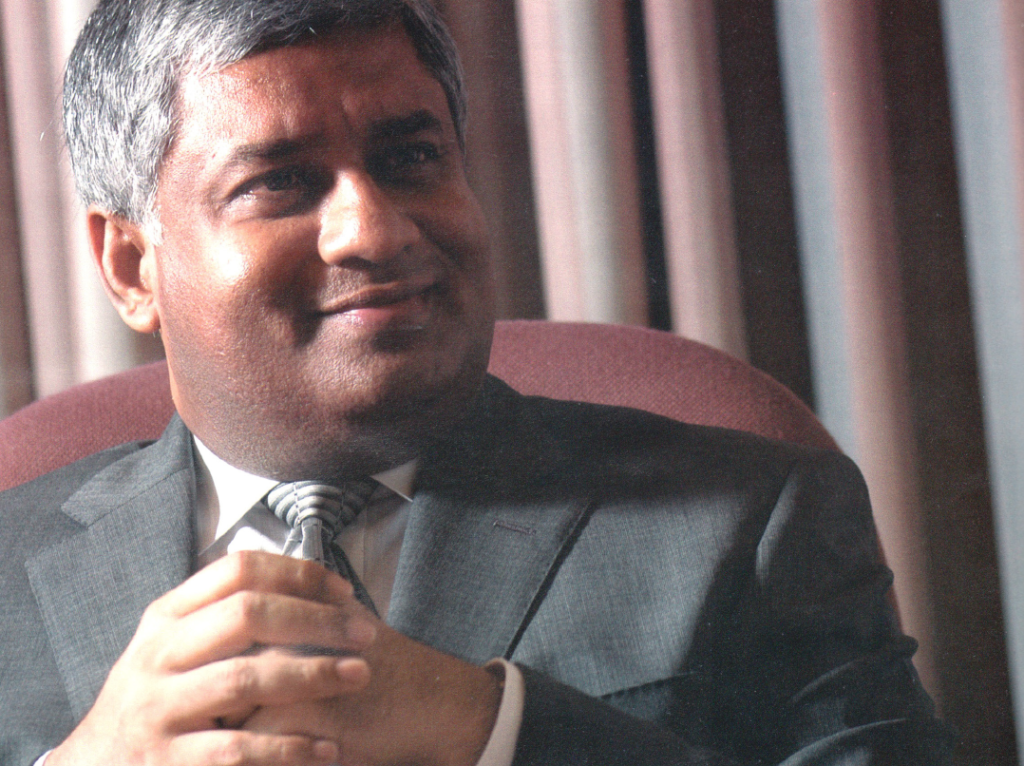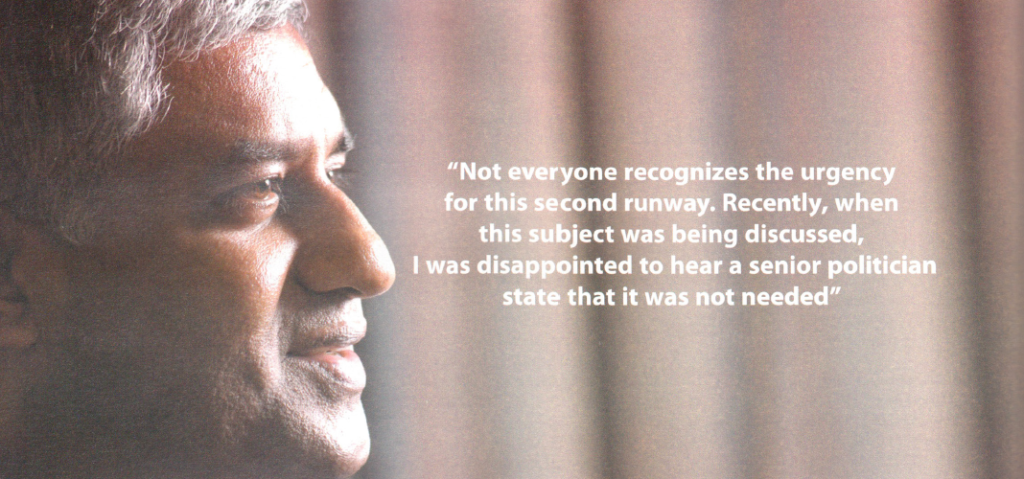Ti ran Alles, Chairman of the Airport and Aviation Services Limited (AASL) discussed with Business Today both the structural and managerial changes that have taken place within the AASL and also set the record straight regarding the controversy surrounding him and his alleged involvement as the go-between for the government and LTTE.

You took over the management of one of the country’s largest transport sector entities when it was undergoing changes, improvements as well as upheavals. What were some of the changes that you yourself introduced?
One of the major changes was the restructuring of the entire administrative structure, the finance department and the way in which finances were handled. A majority of the workers are extremely happy about these changes – in fact, I have made some drastic changes and they have even welcomed them. Amongst the other changes are the efficient management and close supervision of the airport expansion program, so that all work will be completed by September this year. We have already completed part of it-the new pier and the aero bridges, for example. We are now in the process of expanding the arrival and departure halls and before September, I have plans to renovate the VIP lounge and even refurbish the old departure and arrival terminals.
One of the recent trends in the local aviation industry is the introduction of domestic flights. In your opinion, is there a future for the domestic aviation industry?
We have to take a decision and develop the domestic aviation industry. Currently, the only domestic airport in operation is at Ratmalana. Then there are domestic flights to Jaffna and the Sri Lanka Air Force (SLAF) handles most of the other domestic airports as air force bases. Definitely in any country it is a commercial advantage to develop domestic aviation, to develop the airport and establish flying schools etc. We also need the private sector’s involvement in this industry. But, for a planned and coherent development, there needs to be a clear policy and we are now working towards that.
You mentioned that Ratmalana is at present the only domestic airport. It’s also the oldest airport in the country. Why hasn’t this airport been developed further?
There are a lot of restrictions to developing this airport as an international one. With the parliament being around the corner, there are security restrictions, which limits the commercial viability of the airport as an international one. Also, it would be very unrealistic to expand and upgrade the existing runway to accommodate international flights. First, there is a physical limitation on the space available for this expansion and second; the return on our investment would not justify this expense. But we do see the potential of the infrastructure already in place, so we’re planning to develop Ratrnalana Airport into a hub for domestic flights. This has already been decided with the Civil Aviation Authority, and plans are underway to exploit the existing advantages offered by Ratmalana Airport.
The brain drain has been one of Sri Lanka’s biggest human resource challenges. Will you be able to find sufficiently qualified and experienced pilots to keep pace with the domestic aviation expansion?
The problem of finding qualified pilots does not really raise a major concern for the AASL. It could pose a problem for the airlines. But there are other factors, which have to be in place for the dynamic growth of a domestic aviation industry — private sector participation, efficient and reliable infrastructure, clear guidelines and enforcement of regulations are just some of them. It’s up to us to ensure this framework is in place for the domestic aviation sector to, literally, take off.
While awaiting the development of the domestic sector, the current domestic operators are also looking at short haul international flights. All eyes seem to be currently fixed on the short haul Indian market. How will this affect the aviation industry in general?
I think that an increase in the number of operators is a positive sign – we can have as many operators as necessary. It’s good for travelers when there is competition. Right now only Sri Lankan Airlines operates in the Indian sector, so there is definitely room for more local private operators to join this sector. We will also probably see the development of local budget airlines, when operators have access to both domestic and short haul international sectors. Right now there is no budget airline culture, but as we have seen in India, it’s very likely to happen when the options are widened and opportunities given to private operators.
But the expansion of the private airline industry means that they need to have the necessary infrastructure and ground handling support. How is AASL planning to cope with this sudden increase in the requirement for its services?
We are coping quite well with the demand. The only problem right now is that the private airlines need hangar space and we have already identified areas where they can share the hangar space. The AASL will charge a rent for the hangar space provided. The main complaint from private operators is regarding the ground handling charges, which is not managed by AASL but by Sri Lankan Airlines. This is an issue that we are addressing, and currently we’re looking at the possibility of AASL taking this over. I know that Sri Lankan Airlines’ charges are extremely high when compared to other South Asian countries. AASL can manage the ground handling under the current agreement, but we cannot appoint another party. At the moment, we are studying this situation and have informed Sri Lankan Airlines also.
Will other international airlines come to Sri Lanka, because when they do, they have limited access to general maintenance facilities?
Yes, there are issues pertaining to this. The other day the President told me that even Boeing is willing to come here. In most countries easy access to general maintenance is available and airlines have some agreement with regard to the use of these facilities – they come, do the repairs and take off. Painting is also a big business in the airline industry. The technology is such that you can do a repaint of a small aircraft in one day. Sri Lanka has to develop the area of general maintenance and have the capacity to accommodate the repair needs of international airlines.
It was recently announced that Weerawila in the Southern Province has been selected for the construction of a new airport. What made AASL choose this particular location for a new international airport?
We were studying three sites in the Southern Province and finally settled on the current site, which is approximately eight hours drive away from Colombo. Right now we’re trying to get the approval from the Central Environmental Authority and it’s likely to be completed by mid May. In the meantime, we’re doing the other documentation with the Central Aviation Authority and I think that we can start work on the site by May this year. And we hope that the construction can be completed within two years. When complete, the airport will contain a basic terminal, a 4,000 meter runway – even longer than the one at Katunayake – and other aerodrome facilities. We don’t expect as many international flights as the BIA but the airport will be built to accommodate international airlines.
Does the focus on new international airports and a hub for the domestic sector mean that you have completed the development of the BIA?
No of course not, we have many development plans for BIA. For example, BIA will be developed to accommodate the new A380. We’re planning to overlay and widen the present runway to cater to the A380, and work on this will begin in January 2007. We’re hoping to complete this within eight months, as the A380 is not expected to start flying to Sri Lanka before then. The aerobridges for the A380’have already been ordered and will be in place by September this year. As soon as the runway is complete by August 2007, we will be equipped to handle the A380. We’re also looking at building a second runway, and we’re now study-ing five locations around the current airport premises. We have short listed one location and have requested the Divisional Secretary to carry out a survey of the number of houses in that area. We are trying to put together all the data to find out how many families will have to be relocated and so on. Because we have to acquire new land, it will be a challenging task to get under way. But I believe that if the government is firm on the issue of the second runway, then we will definitely move forward.
We can’t continue to operate an international airport with only one runway. Today, if something happens to that runway then the entire country is closed to international traffic. But not everyone recognizes the urgency for this second runway. Recently, when this subject was being discussed, I was disappointed to hear a senior politician state that it was not needed. They don’t realize that if the runway is damaged or can’t be used for some technical reason, nothing will come in or go out of Sri Lanka and we will be completely cut off from the rest of the world. Recently when a private aircraft had a problem we had to close this airport for 10 hours.
Luckily it was only 10 hours and nothing more. This can happen at anytime so a second runway is definitely required.
Within the existing infrastructure and services, what value added services and products can BIA offer in order to attract more flights and perhaps even become a popular refueling/transit point?
I think we could operate an area for aircraft maintenance. In fact, we have been requested several times to operate maintenance centers, where the aircrafts can come here, have the repairs done and go off again. Another area is to provide paint shop facility for aircrafts. We could start these services, and attract a lot of aircraft to visit BIA for maintenance and other services such as painting. So we may become a technical assistance hub for the airline industry.
Looking at the recent history of BIA, there have been a few controversial incidents such as bomb scares and even a highly publicized incident of rape. How is BIA coping with this bad publicity?
Well, bomb scares have been present for the past several years. In the past, there was a time when bomb scares were a threat almost everyday. But we saw this gradually subside. Unfortunately there was a bomb scare recently , which caused panic on a flight and led to the death of a passenger. That was very unfortunate. The phone call regarding this bomb scare had reached the control tower when the flight was already taxiing to takeoff. The control tower had to make a quick decision and inform the captain. He stopped the plane and opened the emergency doors and inflated the chute but one passenger jumped out and missed the chute, and landed right on the tarmac. It is difficult to avoid accidents of this nature, in spite of many precautions taken. And the incidence of rape, which was reported, is one where I have serious doubts. Because this particular lady says that this happened at the time she was departing. I went and saw the room where she says that this incident took place, which is far away from the departure area. This is within the departure area where all the customs, immigration and airline staff are present. She says that she was asked to come with the security guard to the room and after the rape, she was taken back through the normal channel; passing the airline counters, immigration, security checks and into the bus and into the plane. But she never complained at any of these points. Then she goes overseas and returns after 8 or 18 days and then makes a complaint about the incident. She arrives in Sri Lanka and goes to the police station within the airport premises and makes the complaint. While she is making the complaint, a private media channel appeared within 10 minutes at the police station. So I have my serious doubts whether this incident actually happened and what motivated this story.
“The media often accuse the Norwegians as being pro-LTTE. Well then, they should be happy with my participation, as I am certain to be neutral”
Have you had any serious reaction from the public to this incidence of alleged rape within the airport premises?
No, not from the general public. The only reaction has been from a private media channel. This was before the presidential elections, so they tried to exploit this story for political advantage. That’s all I can say. They tried to tarnish the image of the airport and the Minister. The police are currently handling the incident; it’s in courts and we are awaiting the outcome.
You were closely associated to President Rajapaksa , what made you support him, considering your previous lack of involvement in politics?
There is no one particular reason. I was the Chairman of AASL, and I was working very closely with the Minister of Ports, Aviation and Foreign Affairs; Mangala Minister Samaraweera was handling the President’s campaign, so I too became involved in all the activities.
The press has portrayed you as being an envoy of the Rajapaksa government and the airport premises was even listed as a likely venue for the peace talks. What is your reaction to this?
At that time I was not even in\’Olved in the decision to identify the airport premises as a likely venue for the peace talks. I came to know about this from the media. But of course the suggestion never materialized. I do not think that there is anything wrong in the role I have played in facilitating the LTTE’s passage through the airport premises. If we can call on Mr Solheim and ask him to be the go-between, if there is anyone in Sri Lanka who can do the same thing, then why not? If that action helps to bring a permanent peace in this country, then why not? If someone is accusing me of being the go-between for the government and the L TIE, I can only ask what role do the orwegians play? I believe I played the same role. The media often accuse the orwegians as being pro- LTTE. Well then, they should be happy with my participation, as I am certain to be neutral. I cannot understand when people criticize an action such as providing safe passage to the participants of the country’s peace talks. If there is anyone in this country who can do something and solve this problem, then we should pave the way for it to happen. During the LTTE’s recent travel to Geneva, they had already arrived at the airport by the time I got there. So I walked up to them, spoke to them and they went up to the day rooms, which is available to any passenger transiting through the BIA. They were planning to have lunch there when I informed them that they can use the public restaurant and they were quite willing to go there because I was around. Due to security reasons, they did not want to move around inside. Since I was present, they came to the restaurant and had lunch with me.
But why has such a simple incident caused so much controversy?
I believe it all comes down to politics. Perhaps the opposition doesn’t like something positive happening with the Rajapaksa administration. Maybe they feel that my involvement will bring some good results and that is why they want to attack me. I don’t think that any individual has been attacked in such depth and for such a long duration, as I have.
You have worked in the private sector and have also been an entrepreneur. Now that you are working in the public sector, what are the differences you see between the public and private sector?
There is a huge difference. The flexibility of doing things as and when you want and the way you want to do it, is not available in the public sector. But of course in my case I have had no major problems. For the AASL, I have an extremely competent minister. Minister Mangala Samaraweera is easy to work with. From the day I took on this job, I think of it as my company and I take decisions based on that outlook – this is necessary, or you will not be able to make firm decisions. So far there has been no political pressures on decision making. Even when there is an issue, I have managed to go to speak with Minister Samaraweera, even to the President, and explain my perspective and the facts to them. They have always accepted my judgment and decision, if it is the right decision for the issue. That’s probably why I have had no problems so far.
Would you consider heading AASL, your biggest professional achievement?
It has certainly been a good experience because I think that this is one of the largest institutions in the government sector. I think that I have been able to contribute something positive, since I have been in the private sector and still I am in the private sector, and I have always tried to run AASL like a private organization.
What do you envision for Sri Lanka’s aviation future?
There is definitely a bright future for the aviation industry in Sri Lanka. But a lot of work needs to be done and the main obstacle is the security situation. Minister Samaraweera had a lot of plans to develop the Koggala area and establish international aviation and technical training schools. But with the current security situation, we face many challenges in implementing these plans.






